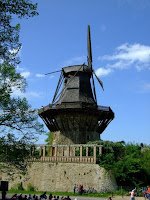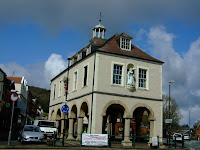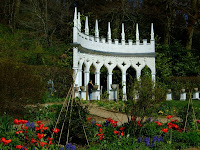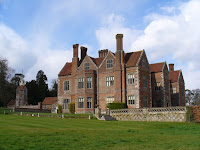 A large area around the Schloss Sanssouci (Castle “without a care”) has been turned into a park that contains a number of historic attractions. There is the ‘New’ Palace with its grand servants’ quarters (now a university building); a historic windmill; the Chinese Teahouse; Schloss Charlottenhof; Roman Baths; the Orangerie; the ‘New’ Rooms; the Bildergalerie; the Belvedere; and Schloss Sanssouci itself.
A large area around the Schloss Sanssouci (Castle “without a care”) has been turned into a park that contains a number of historic attractions. There is the ‘New’ Palace with its grand servants’ quarters (now a university building); a historic windmill; the Chinese Teahouse; Schloss Charlottenhof; Roman Baths; the Orangerie; the ‘New’ Rooms; the Bildergalerie; the Belvedere; and Schloss Sanssouci itself. A day-ticket affords entry to them all (except the university buildings) and as they are spread over 287 hectares, there is a fair bit of ground to cover to get the full ticket value.
A day-ticket affords entry to them all (except the university buildings) and as they are spread over 287 hectares, there is a fair bit of ground to cover to get the full ticket value.Once again, we were warned about the queues so started the day with the main attraction, Schloss Sanssouci, the oldest building in the complex, started by Frederick the Great in 1747. As well as the main staterooms one gets to visit the kitchen and the Ladies Wing. Frederick was very
 keen on the Rococo style so the entire place is entirely over-the-top Rococo ostentation.
keen on the Rococo style so the entire place is entirely over-the-top Rococo ostentation.One practical feature were wooden boards set into the tile floor alongside the kitchen worktops. Presumably to reduce the effect of standing on a hard, cold, floor all day: a nice touch.
From there, it was a quick trip up and down the mill which, whilst on the historic site, was entirely rebuilt in 1993 after destruction in 1945. Just
 below the Mill is the Neue Kammern, an original orangery converted in to a guest wing: another feast for the eyes.
below the Mill is the Neue Kammern, an original orangery converted in to a guest wing: another feast for the eyes.Climbing back up the hill there is the current orangery, the largest palace in the complex and while it is an orangery on one side, it is anything but on the other. The palace contains a room full of copies of Raphael paintings and the climb to the tower is worth it for the view over the park and environs.
 In the northwest corner of the park is the partly restored Belvedere and from there we headed south to the Neue Palais, or New Palace. (it was ‘new’ in 1763) This ornate baroque building is one of Germany’s most beautiful palaces. Again, the interior is Rococo writ large.
In the northwest corner of the park is the partly restored Belvedere and from there we headed south to the Neue Palais, or New Palace. (it was ‘new’ in 1763) This ornate baroque building is one of Germany’s most beautiful palaces. Again, the interior is Rococo writ large. Further south down one of the long avenues we found the turning to head east, across the hippodrome – which hasn’t seen horse in a long while – to the delightful little Schloss Charlottenhof, built in 1829 for the heir to the throne, later King Fredrick Wilhelm IV.
Further south down one of the long avenues we found the turning to head east, across the hippodrome – which hasn’t seen horse in a long while – to the delightful little Schloss Charlottenhof, built in 1829 for the heir to the throne, later King Fredrick Wilhelm IV.It is a intimate Roman villa with a most unusual Tent Room made of striped canvas to give the illusion of being in a tent.
 The day was going quickly so it was a quick peek at the Roman Baths and the Chinese Teahouse before heading back up to the Bildergalerie, Germany’s oldest purpose built museum building. Once again Fredrick’s taste in baroque and rococo are stamped all over it and it would be worth visiting even if it had no paintings on the wall. Beautifully restored it simply gleams with gold leaf.
The day was going quickly so it was a quick peek at the Roman Baths and the Chinese Teahouse before heading back up to the Bildergalerie, Germany’s oldest purpose built museum building. Once again Fredrick’s taste in baroque and rococo are stamped all over it and it would be worth visiting even if it had no paintings on the wall. Beautifully restored it simply gleams with gold leaf. Tired but satisfied, we collapsed into a bus for a short trip to Potsdam town centre. It was here, in 1945 that Germany was carved up by the Allies. At the far end of the pedestrianised main street we could see the spire of Peter and Paul Church. We have been into hundreds of chapels, churches, abbeys and cathedrals but this one was unique in the decoration.
Tired but satisfied, we collapsed into a bus for a short trip to Potsdam town centre. It was here, in 1945 that Germany was carved up by the Allies. At the far end of the pedestrianised main street we could see the spire of Peter and Paul Church. We have been into hundreds of chapels, churches, abbeys and cathedrals but this one was unique in the decoration.





































